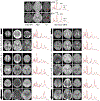Neuroimaging in the term newborn with neonatal encephalopathy
- PMID: 34736808
- PMCID: PMC9135955
- DOI: 10.1016/j.siny.2021.101304
Neuroimaging in the term newborn with neonatal encephalopathy
Abstract
Neuroimaging is widely used to aid in the diagnosis and clinical management of neonates with neonatal encephalopathy (NE). Yet, despite widespread use clinically, there are few published guidelines on neuroimaging for neonates with NE. This review outlines the primary patterns of brain injury associated with hypoxic-ischemic injury in neonates with NE and their frequency, associated neuropathological features, and risk factors. In addition, it provides an overview of neuroimaging methods, including the most widely used scoring systems used to characterize brain injury in these neonates and their utility as predictive biomarkers. Last, recommendations for neuroimaging in neonates with NE are presented.
Keywords: Advanced MRI techniques; Asphyxia; Diffusion-tensor imaging; Diffusion-weighted imaging; Hypoxic-ischemic brain injury; Magnetic resonance spectroscopy imaging; Neonatal encephalopathy; Neonates; Outcome prediction; Predictive values.
Copyright © 2021. Published by Elsevier Ltd.
Conflict of interest statement
Declaration of competing interest
The authors have no conflicts of interest to disclose.
Figures



References
-
- Nelson KB, Leviton A. How much of neonatal encephalopathy is due to birth asphyxia? Am J Dis Child 1991;145:1325–31. - PubMed
-
- Kurinczuk JJ, White-Koning M, Badawi N. Epidemiology of neonatal encephalopathy and hypoxic-ischaemic encephalopathy. Early Hum Dev 2010;86:329–38. - PubMed
-
- Lawn JE, Cousens S, Zupan J. Lancet Neonatal Survival Steering T. 4 million neonatal deaths: when? where? why? Lancet 2005;365:891–900. - PubMed

